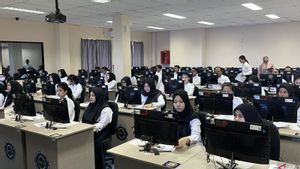JAKARTA – Scientists have found a new way to reveal the process of rocky planet formation. They made this discovery using data from the James Webb Space Telescope.
In the old theory, ice pebbles that formed outside the protoplanetary disk were the initial components of planet formation. It is estimated that these ice pebbles move towards the star, then pour solid matter and water onto the planet.
The sequence of this process became Webb's observation. This telescope belonging to the United States Aeronautics and Space Administration (NASA) is used to observe the process of releasing cold water vapor when ice pebbles move to warm areas.
Later, Webb would confirm the connection between water vapor in the inner disk and the flow of ice pebbles in the wider disk. According to NASA researchers, the findings from Webb can be studied to solve the process of planet formation.
“In the past, we had a very static picture of planet formation, almost like isolated zones where planets formed. Now we actually have evidence that these zones can interact with each other," said Researcher Colette Salyk.
So far, researchers have used Webb's Mid-Infrared Instrument (MIRI) to study four disks of stars estimated to be between 2 and 3 million years old.
SEE ALSO:
Of the four stellar disks they studied, two of them are predicted to experience a gravel shift and deliver the gravel to a distance equivalent to the orbit of Neptune.
In this process, Webb's role is needed. They will determine whether the star's disk has abundant water in the interior of the rocky planet. Apart from using MIRI, researchers will also use a Medium Resolution Spectrometer (MRS).
The research results they have so far show that the protoplanetary disk has cooler water, but the larger disk has hotter water. Scientists will continue this research to solve the process of planet formation.
The English, Chinese, Japanese, Arabic, and French versions are automatically generated by the AI. So there may still be inaccuracies in translating, please always see Indonesian as our main language. (system supported by DigitalSiber.id)


















